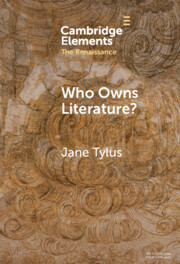Refine search
Actions for selected content:
111 results
Chapter 6 - Kant’s Critique of Achenwall’s Account of Property in His Feyerabend Lectures
-
-
- Book:
- Kant's Lectures on Political Philosophy
- Published online:
- 18 July 2025
- Print publication:
- 07 August 2025, pp 103-121
-
- Chapter
- Export citation
10 - How to Make Gifts with Words
- from Part III - Reinach and Legal Concepts
-
-
- Book:
- Reinach and the Foundations of Private Law
- Published online:
- 20 July 2025
- Print publication:
- 07 August 2025, pp 254-276
-
- Chapter
-
- You have access
- Open access
- HTML
- Export citation
8 - The Ontology of Liberties
- from Part II - Reinach and Private Law Theory
-
-
- Book:
- Reinach and the Foundations of Private Law
- Published online:
- 20 July 2025
- Print publication:
- 07 August 2025, pp 189-216
-
- Chapter
-
- You have access
- Open access
- HTML
- Export citation
5 - Condominium Ownership
-
- Book:
- Property Law in China
- Published online:
- 09 July 2025
- Print publication:
- 24 July 2025, pp 126-152
-
- Chapter
- Export citation
8 - Specificities of the International Community and Legitimacy
- from Part III - The Question of Legitimacy at the International Level
-
- Book:
- The Law and Politics of International Legitimacy
- Published online:
- 14 July 2025
- Print publication:
- 24 July 2025, pp 121-156
-
- Chapter
- Export citation
1 - Heroes and Villains
-
- Book:
- The CEO
- Published online:
- 19 June 2025
- Print publication:
- 19 June 2025, pp 1-16
-
- Chapter
- Export citation
30 - Ownership for and against Control
- from Part III - Applications
-
-
- Book:
- The Cambridge Handbook of Experimental Jurisprudence
- Published online:
- 17 May 2025
- Print publication:
- 05 June 2025, pp 502-513
-
- Chapter
- Export citation
8 - Justifying Ownership
- from Part III - Property Law
-
- Book:
- Natural Property Rights
- Published online:
- 17 April 2025
- Print publication:
- 24 April 2025, pp 145-158
-
- Chapter
- Export citation
11 - Artificial Intelligence and Intellectual Property Law
- from Part II - AI, Law and Policy
-
-
- Book:
- The Cambridge Handbook of the Law, Ethics and Policy of Artificial Intelligence
- Published online:
- 06 February 2025
- Print publication:
- 13 February 2025, pp 211-227
-
- Chapter
-
- You have access
- Open access
- HTML
- Export citation
5 - Spirits in the Landscape
-
- Book:
- The Shamanism of Eco-Tourism
- Published online:
- 30 January 2025
- Print publication:
- 06 February 2025, pp 104-124
-
- Chapter
- Export citation
Chapter 3 - Ownership and Permanence
-
- Book:
- E-books and ‘Real Books’
- Published online:
- 07 December 2024
- Print publication:
- 23 January 2025, pp 61-92
-
- Chapter
-
- You have access
- Open access
- HTML
- Export citation
2 - Masters of Men and Beasts: The Early Roman Fantasia of Ownership
- from Part I - Masters of Men and Beasts
-
- Book:
- From Masters of Slaves to Lords of Lands
- Published online:
- 28 November 2024
- Print publication:
- 16 January 2025, pp 75-124
-
- Chapter
- Export citation
3 - The Dominus Enters the Law
- from Part I - Masters of Men and Beasts
-
- Book:
- From Masters of Slaves to Lords of Lands
- Published online:
- 28 November 2024
- Print publication:
- 16 January 2025, pp 125-159
-
- Chapter
- Export citation
6 - Introduction to Part II: From Pierson v. Post to Johnson v. M’Intosh
- from Part II - From Masters to Lords
-
- Book:
- From Masters of Slaves to Lords of Lands
- Published online:
- 28 November 2024
- Print publication:
- 16 January 2025, pp 231-235
-
- Chapter
- Export citation

Who Owns Literature?
- Early Modernity's Orphaned Texts
-
- Published online:
- 09 January 2025
- Print publication:
- 30 January 2025
-
- Element
- Export citation
Chapter 11 - Economic and Political Considerations
-
- Book:
- Wind Turbines
- Published online:
- 24 January 2025
- Print publication:
- 19 December 2024, pp 274-302
-
- Chapter
- Export citation
6 - Transforming the Corporation
-
- Book:
- Reimagining Prosperity
- Published online:
- 18 October 2024
- Print publication:
- 21 November 2024, pp 171-203
-
- Chapter
-
- You have access
- Open access
- HTML
- Export citation

Recycling the Roman Villa
- Material Salvage and the Medieval Circular Economy
-
- Published online:
- 08 November 2024
- Print publication:
- 31 October 2024
Perceived corruption, economic freedom, and firms in India
-
- Journal:
- Business and Politics / Volume 26 / Issue 4 / December 2024
- Published online by Cambridge University Press:
- 25 October 2024, pp. 621-648
-
- Article
- Export citation
11 - NFTs and Copyright Law
- from Part IV - Intellectual Property and Ownership Rights
-
-
- Book:
- The Cambridge Handbook of Law and Policy for NFTs
- Published online:
- 02 November 2024
- Print publication:
- 17 October 2024, pp 217-237
-
- Chapter
- Export citation
